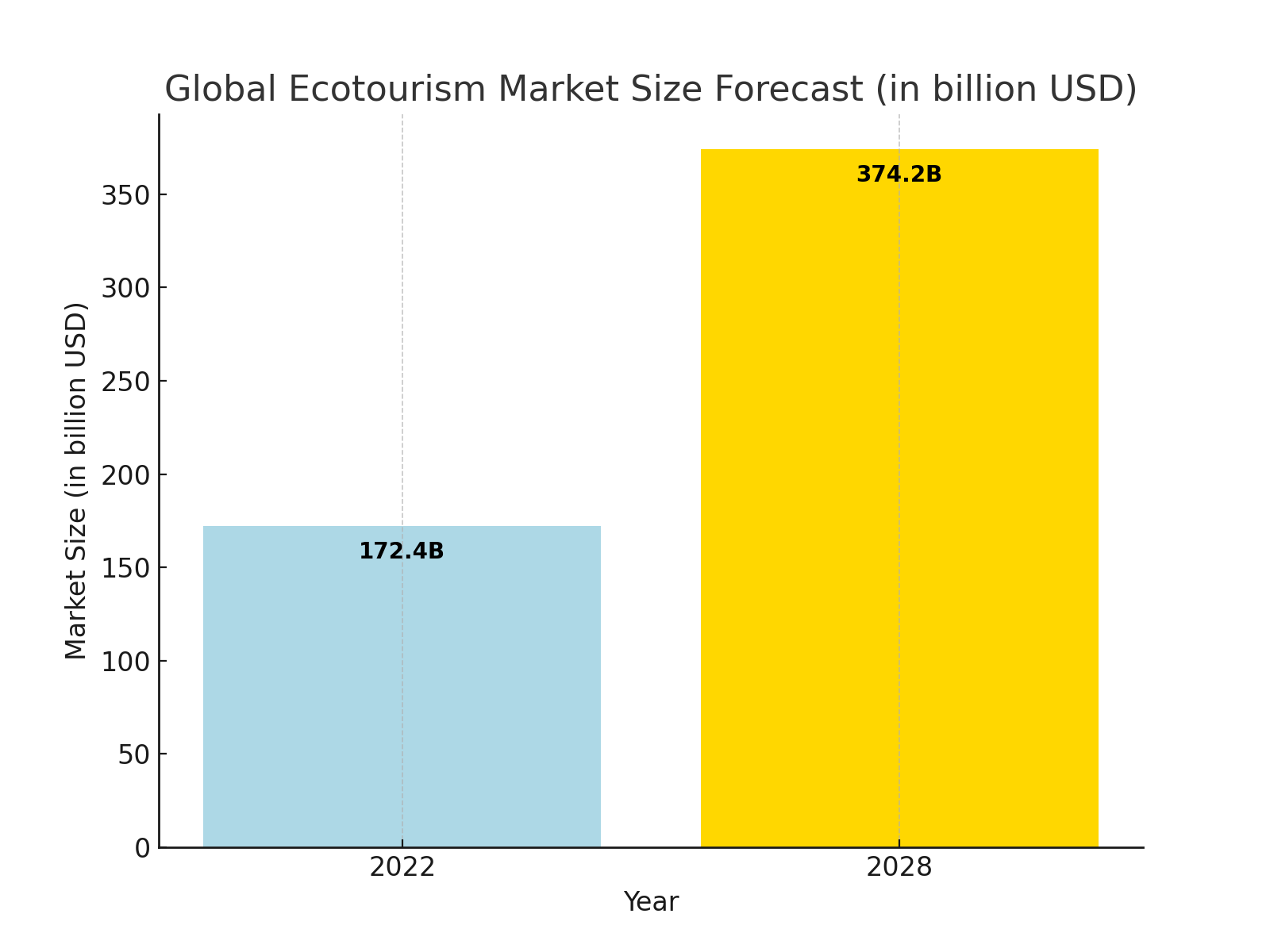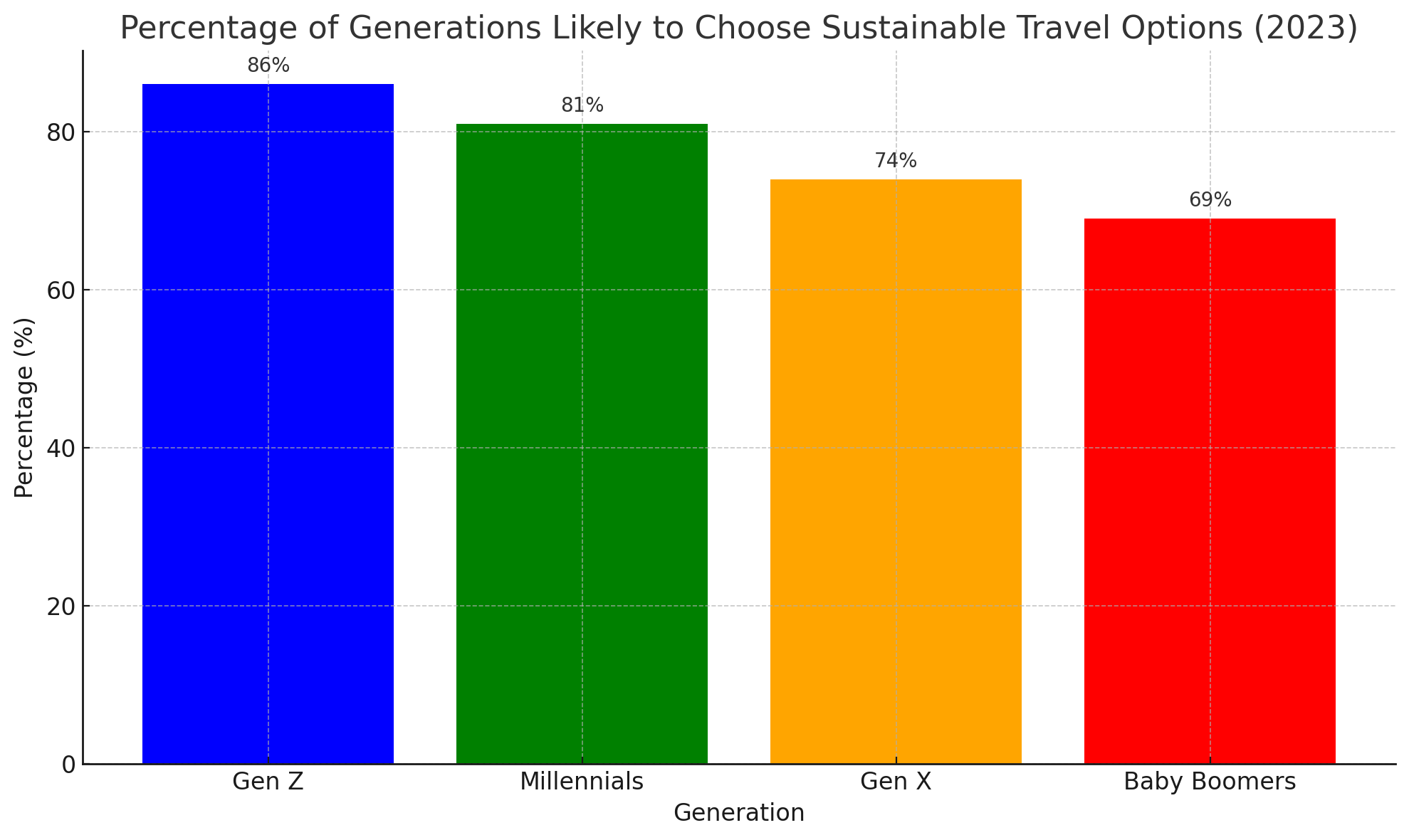Have you ever wondered how your travel footprint affects the world? Sustainable tourism is a critical approach to travel that emphasizes responsibility for its economic, social and environmental impacts. It addresses the needs of visitors, the industry, the environment and host communities. Why is it important? Because sustainable tourism tackles global challenges head-on, from climate change and biodiversity loss to poverty and inequality.
This article takes a deep dive into the world of sustainable tourism. We’ll share relevant, reliable, and compelling data on various aspects of this important topic. Get ready for a thorough review of the current state, challenges, and future trends and opportunities in sustainable tourism.
Table of Contents
The State of Sustainable Tourism
The global landscape

In 2022, the global sustainable tourism market was valued at a whopping $172.4 billion. By 2028, it is projected to grow to $374.2 billion. This growth rate has even exceeded the expectations of the United Nations World Tourism Organization (UNWTO), with an increase of 7% in 2017 and 6% in 2018. But what’s driving this trend?
Traveler preferences
Booking.com’s 2023 Sustainable Travel Report shows a strong desire for sustainable travel among consumers, with 76% of travelers expressing a desire to travel more sustainably. This is a significant increase from previous years and underscores the growing importance of environmentally conscious travel habits. However, nearly half of the travelers surveyed believe that sustainable travel options are too expensive, although a significant percentage are willing to pay extra for sustainable certified travel options. Booking.com has responded by recognizing more than 500,000 accommodations worldwide for their sustainability efforts with a Travel Sustainable badge.
To emphasize the importance of sustainable travel, a travel survey from TheVacationer.com confirms that 71% of American adults are willing to pay more to reduce their carbon footprint. The survey underscores travelers’ strong intention to make green travel choices, reflecting a broad consensus on the importance of sustainability in travel.
Demographics favoring sustainable travel
Polupations

According to the 2023 Global Survey, Gen Z and Millennial travelers are most likely to choose sustainable travel options, with 86% and 81%, respectively, saying they would. In contrast, only 69% of Baby Boomers and 74% of Gen X travelers said the same.
Who favors more sustainable travel in the USA?

The Vacationer’s Sustainable Travel Survey 2023 found that women are more likely than men to consider sustainable travel important. Specifically, 30.42% of women said it was “Very Important,” compared to 26.71% of men. In addition, 57.01% of women said it was “Somewhat Important,” compared to 49.15% of men, for a total of 87.43% of women recognizing some level of importance to sustainable travel, compared to 75.86% of men.
Which countries are most sustainable?
| RANK | COUNTRY | SCORE | PERFORMANCE BY SDG |
| 1 | Finland | 86.76 | Outstanding |
| 2 | Sweden | 85.98 | Outstanding |
| 3 | Denmark | 85.68 | Outstanding |
| 4 | Germany | 83.36 | Very High |
| 5 | Austria | 82.28 | Very High |
| 6 | France | 82.05 | Very High |
| 7 | Norway | 82.0 | Very High |
| 8 | Czechia | 81.87 | High |
| 9 | Poland | 81.8 | High |
| 10 | Estonia | 81.68 | High |
The Sustainable Development Report highlights The overall performance of all 193 UN Member States in progressing towards achieving all 17 SDGs in 2023. The results are interpreted with a score that represents the percentage of SDG achievement. A score of 100 means all SDGs are achieved.
Leaders in sustainable tourism
Who’s leading the way? The Sustainable Top 100 Destinations ranks the world’s most sustainable places, focusing on nature, culture, community, green economy, and climate efforts. In 2023, destinations such as Aspen, Colorado (USA), Alto Minho (Portugal), Amarante (Portugal), Baie de Somme (France), and Belsh (Albania) stood out. These places are pioneers in preserving natural and cultural heritage, engaging local communities, promoting green businesses, and striving for a smaller carbon footprint.
Environmental Impact
The global appeal of tourism, with its significant contribution to GDP and trade worldwide, comes at a high environmental cost. Accounting for 10% of global GDP, 7% of global trade, and a significant 5% of global CO2 emissions, tourism’s impact on the environment is significant. In addition to carbon emissions, the sector’s effects include waste generation, excessive water consumption, land degradation, and biodiversity loss.
Sustainable Tourism: A Greener Way
In contrast, sustainable tourism is about having a low impact on the environment and local culture, while helping to create future jobs for local people. It’s committed to reducing the negative impacts of traditional tourism through practices such as energy efficiency, effective waste management, water conservation and wildlife protection. Most importantly, sustainable tourism doesn’t just minimize harm; it can also catalyze positive environmental change, such as restoring ecosystems, enhancing natural capital, and promoting environmental awareness.
Conservation case studies
Community-based natural Resource Management in Namibia (CBNRM): is a testament to the potential of sustainable tourism. By empowering local communities to manage and benefit from their natural resources, particularly wildlife, the program has spearheaded the recovery of endangered species such as black rhinos and elephants. It has also established more than 500 community conservancies that generate more than $10 million annually from tourism and related activities.
The Great Himalayan Trail is another sustainable tourism success story. Spanning eight countries, this network of trekking routes promotes sustainable tourism by supporting local livelihoods, preserving cultural diversity, and conserving natural resources. It also plays a critical role in climate change adaptation and mitigation, increasing the resilience of mountain ecosystems and communities while reducing greenhouse gas emissions from transportation and lodging.
Jeju Island’s approach to low-carbon tourism involves policy and institutional reforms, behavioral changes, and climate action initiatives aimed at integrating climate action with sustainable tourism. This includes adopting a low-carbon approach to reducing greenhouse gas emissions, particularly from air travel, and increasing the island’s resilience to the impacts of climate change.
In Uzbekistan, agritourism is emerging as a key mechanism for sustainable rural development, bringing economic, cultural and social benefits to farmers and rural communities. It’s seen as an important source of additional income, contributing to rural development by providing alternative activities to increase farm income and addressing rural unemployment through structural change.
Economic impact
Sustainable tourism is a robust economic opportunity, especially for local communities. By creating jobs, increasing incomes, diversifying livelihoods and improving living standards, sustainable tourism breathes life into local economies.
Local benefits and poverty reduction
The UNWTO highlights tourism as a vital source of income for many developing countries and a sector with significant potential for poverty alleviation. However, a challenge remains: ensuring that tourism revenues benefit local communities and do not leak to foreign investors and intermediaries. Sustainable tourism addresses this by promoting local ownership, participation and empowerment, and by promoting local products and services.
Your FREE Guide For Budget Traveling 🤫
Are you ready to travel the world without breaking the bank? Our Budget Travel Kit is designed for savvy travelers like you who want to explore more for less.
Don’t miss out on this invaluable resource. Click the link below and follow the steps to get access to your budget travel kit ⬇️ ⬇️

Cost-Effectiveness and Profitability
Transitioning to sustainable practices is smart business. The World Travel and Tourism Council (WTTC) and the International Finance Corporation (IFC) point out that sustainable tourism can increase the competitiveness and profitability of tourism businesses. This includes reducing operating costs – energy costs by 20-30%, water costs by 25-50%, and waste costs by 10-20%. Investments in sustainable projects offer attractive returns: 14-70% for energy efficiency, 7-27% for water efficiency, and 5-25% for waste management initiatives.
Sustainable Tourism vs. Traditional Tourism
When sustainable tourism is compared to traditional models, the benefits go beyond immediate economic gains. Sustainable tourism promotes economic diversification, innovation and entrepreneurship, and improves the quality and resilience of tourism products and services. This approach aligns with the Sustainable Development Goals (SDGs) and contributes to global efforts to end poverty, protect the planet, and ensure peace and prosperity.
The impact of sustainable tourism on local economies is profound, stimulating development and growth while ensuring that benefits are felt at the community level. By aligning with the 2030 Agenda for Sustainable Development, sustainable tourism not only advances all 17 SDGs, but also ensures a more sustainable, inclusive, and prosperous future for all.
Social and cultural impact
Sustainable tourism is also about preserving and enhancing local cultures and traditions. By celebrating cultural diversity, promoting intercultural dialogue and fostering local pride, sustainable tourism plays a key role in preserving and nurturing cultural heritage. This includes both tangible assets, such as historic sites, and intangible assets, like traditional crafts, music and dance. Cultural heritage is a cornerstone of tourism, attracting visitors who want to explore the uniqueness of their destinations. Sustainable tourism ensures that these cultural expressions are protected and celebrated and that they will endure for future generations.
Community engagement and empowerment
Sustainable tourism is a catalyst for the empowerment of local communities. It promotes their involvement in tourism planning and management, strengthens their capacities and improves access to essential services. UNWTO highlights tourism’s potential to promote social inclusion, gender equality, youth empowerment and human rights. Community-based tourism is a particularly effective model that directly benefits local communities and reflects their values and environment.
Take the example of the Maasai Mara Women’s Group in Kenya. This initiative empowers women through tourism-related activities, improving their livelihoods while conserving the region’s natural and cultural heritage. Such initiatives demonstrate the profound social benefits that sustainable tourism can bring, fostering self-reliance, social cohesion and an enriched quality of life.
Balancing growth with cultural preservation
However, sustainable tourism faces the challenge of maintaining cultural authenticity during growth. Issues such as the commodification of culture, the displacement of communities, and the erosion of cultural values pose significant threats. These problems often result from unchecked tourism development, inadequate regulation, and the pressures of mass tourism and globalization.
Challenges to Sustainable Tourism
There are many hurdles to implementing sustainable practices in the tourism industry. These challenges range from a lack of awareness and understanding to a lack of essential financial and technical resources. The industry also faces inadequate incentives and regulations, as well as a lack of coordination and cooperation among businesses, communities, and tourists themselves.
For example, many tourism operators may not fully understand the benefits or feasibility of sustainable tourism because they lack the necessary skills or tools to implement such practices. On the consumer side, there’s often a gap in awareness of the environmental and social impacts of their travel choices, reinforced by a lack of accessible information or alternatives for more sustainable travel.
The persistence of unsustainable practices
Despite a growing awareness of sustainable tourism, the persistence of unsustainable practices remains high, with serious implications for environmental, economic, and social well-being. Overdevelopment, pollution, resource depletion and habitat destruction are just a few examples of how traditional tourism models can undermine the very foundations on which they depend.
The UNWTO highlights several unsustainable practices such as overdevelopment, pollution and cultural degradation that threaten not only the sustainability of destinations but also the quality of life for local communities and the overall experience for visitors. The World Economic Forum (WEF) provides stark statistics showing that tourism is responsible for 8% of global greenhouse gas emissions, 10% of global plastic pollution and 20% of global water consumption.
Overtourism is a critical challenge that is leading to a crisis of confidence and reputation in the industry. Destinations overwhelmed by visitors suffer from strained infrastructure, environmental degradation, and diminished quality of life for residents, challenging the sustainability and competitiveness of tourism sectors worldwide.
Navigating to sustainable solutions
The way forward is to overcome these barriers through increased awareness, better access to resources and stronger regulatory frameworks. Promoting collaboration and partnership among all tourism players is critical to the widespread adoption of sustainable practices. By addressing these challenges head-on, the tourism industry can move toward a more sustainable, equitable and profitable future, ensuring the long-term conservation and enjoyment of the world’s natural and cultural treasures.
Future trends and opportunities
As we look to the horizon of sustainable tourism, it’s clear that the landscape is rapidly evolving, shaped by technological advances, policy shifts, changing consumer preferences and innovative business models. Let’s explore these emerging trends that are setting the stage for the future of travel.
Technology Innovations
The role of technology in reshaping sustainable tourism cannot be overstated. From artificial intelligence and blockchain to biometrics and big data, technology offers unprecedented opportunities to improve the efficiency and accessibility of tourism. These innovations facilitate better monitoring and management of tourism’s environmental footprint, ensuring a more sustainable future for the industry.
Policy developments
Key policy frameworks, including the Paris Agreement, the Sustainable Development Goals (SDGs), and the New Urban Agenda, provide important guidance for aligning tourism practices with global sustainability goals. These developments address critical issues such as climate change, urbanization, and social inequality, and challenge the tourism sector to adapt and proactively respond.
Changes in consumer behavior
The emergence of the conscious traveler marks a significant shift in consumer behavior. Today’s tourists increasingly seek personalized, authentic experiences that align with their values and highlight the importance of sustainability. This trend creates new market opportunities and places greater responsibility on tourism industry players to meet these evolving demands.
New business models
The adoption of business models such as the circular economy, the sharing economy, and social enterprise is transforming the tourism landscape. These models promote principles such as resource efficiency, waste reduction, and social impact, redefining the value proposition of tourism to prioritize sustainability and collaboration.
Statistical Forecasts
The trajectory of sustainable tourism points to significant growth and expansion. The UNWTO forecasts that international tourist arrivals will reach 1.8 billion by 2030, with domestic tourism four times that number. Emerging markets, particularly in Asia, Africa and the Middle East, will drive this growth, accounting for 57% of international arrivals by 2030.
The Global Sustainable Tourism Dashboard offers a promising outlook, projecting improvements in key sustainability indicators such as carbon emissions, energy and water use, waste management, and biodiversity conservation. These improvements are expected to meet, if not exceed, the targets set by UNWTO and other international bodies, ushering in a more sustainable era for tourism.
In summary, the future of sustainable tourism is dynamic, driven by innovation, policy alignment, consumer awareness and sustainable business practices. As the industry moves forward, these trends and forecasts underscore the collective journey towards a more responsible and sustainable tourism sector capable of meeting the challenges of the 21st century.
Frequently Asked Questions
How Does Sustainable Tourism Impact Local Cultures and Traditions?
Sustainable tourism plays a crucial role in preserving and promoting local cultures and traditions. By prioritizing experiences that respect and celebrate cultural heritage, sustainable tourism encourages travelers to engage with and learn from the local communities they visit. This respectful interaction helps protect cultural identities, supports the revival of traditional crafts, and provides a platform for cultural exchange, enriching both the visitor’s experience and the host community’s social fabric.
Can Sustainable Tourism Contribute to Wildlife Conservation?
Yes, sustainable tourism can significantly contribute to wildlife conservation efforts. By integrating conservation with economic opportunities, such as wildlife tours and eco-friendly lodges, sustainable tourism provides a financial incentive to protect natural habitats and endangered species. Funds generated from sustainable tourism activities can be reinvested into conservation projects, anti-poaching efforts, and community education programs, creating a virtuous cycle that benefits both the environment and local populations.
What Role Do Governments Play in Promoting Sustainable Tourism?
Governments have a critical role in promoting sustainable tourism through policy-making, regulation, and funding initiatives. They can establish guidelines and standards for sustainable practices, provide incentives for businesses to adopt eco-friendly operations, and invest in infrastructure that supports sustainable travel. Governments can also engage in international cooperation to share best practices and support global sustainability goals, ensuring that tourism development is aligned with environmental conservation and social welfare.
How Can Local Communities Benefit from Sustainable Tourism?
Local communities benefit from sustainable tourism through job creation, economic diversification, and improved infrastructure. Sustainable tourism models prioritize local employment, sourcing, and entrepreneurship, ensuring that the economic benefits of tourism are felt within the community. Additionally, sustainable tourism initiatives often involve community participation in decision-making processes, empowering residents and ensuring that tourism development meets their needs and respects their way of life.
What Are Some Common Misconceptions About Sustainable Tourism?
Common misconceptions about sustainable tourism include the beliefs that it is more expensive than conventional tourism, that it only applies to nature-based travel, and that individual actions cannot significantly impact the industry. However, sustainable tourism encompasses a wide range of travel experiences and can often be cost-competitive with traditional options. Individual choices, such as selecting eco-friendly accommodations or reducing waste, collectively make a substantial difference in promoting sustainability in the tourism sector.



